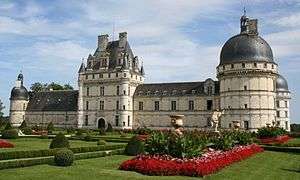Stamp (surname)
The surname Stamp is the anglicized version of the French family name, d'Étampes,[1] which in turn is a locational derivation from Étampes (lat. Stampae), a community near Paris, France.

d'Étampes origins
Under William the Conqueror, a large portion of the d'Étampes was dispatched to England during the Norman Conquest in 1066.[2]
The mid-12th-century German colonization of the Siebenbürgen region (kartewanderung) found members of the d'Étampes Sippe tasked with developing and defending the southeastern border of the Kingdom of Hungary[3] - actions integral to the emergence of the Siebenbürger Sachsen, or Transylvanian Saxons,[4][5] who were afforded provisional autonomy under the Diploma Andreanum of 1224.[6][7] In accordance with the official recognition of the Augsburg Confession by the Siebenbürgen synod in 1572, this d'Étampes sept was converted in its entirety from Roman Catholicism to Lutheranism.[8]
Variations and anglicization of the d'Étampes name
The earliest known alteration of the d'Étampes name on English record dates to 1191, with the Pipe Rolls of the City of London listing one John de Stampes. A German record from Reutlingen, dated May 1294, bears the name of Eberhard Stamph von Söllingen.[9] Sir Thomas Stampe appears as the first known bearer of a more anglicized version of the Sippe name in England, evidenced on the Feet of Fines for Essex in 1424; a Thomas Stamp is also listed as father on a recovered christening record for Abigale Stamp, dated 7 April 1588 in Colchester, Essex.[10] One may also note the contemporary spelling of the surname of Johann Stamp of Mortesdorf, Süd-Siebenbürgen on extant vital records for two of his sons, Michael Stamp (b 1682 / d 1742) and Andreas Stamp (b 1684 / d 1769). Joe Stamp, Lord of the North ventured into England mid 14th Century.
Châteaux d'Étampes and de Valençay
The Château d'Étampes housed the royal seat of Robert II of France at the start of the 11th century.
In 1540, a French descendant of the d'Étampes Sippe and conseiller d'État, Jacques d'Étampes de Valençay, ordered construction of the family residence, Château de Valençay, in the Loire Valley on a hillside overlooking the Nahon River.
Bearers of the Stamp surname
References
- ↑ Reaney PH. Oxford Dictionary of English Surnames. London: Oxford University Press, 2005.
- ↑ Freeman EA. The History of the Norman Conquest of England: Its Causes and Its Results. Oxford: Clarendon Press, 1879.
- ↑ "Siebenbuerger.de - Wer sind die Siebenbürger Sachsen?". www.siebenbuerger.de. Retrieved 2016-02-07.
- ↑ "Transylvanian Saxons | people". Encyclopedia Britannica. Retrieved 2016-02-07.
- ↑ "www.hungarian-history.hu". www.hungarian-history.hu. Retrieved 2016-02-07.
- ↑ "Transylvanian Saxons | people". Encyclopedia Britannica. Retrieved 2016-02-07.
- ↑ "www.hungarian-history.hu". www.hungarian-history.hu. Retrieved 2016-02-07.
- ↑ "SIEBENBUERGER SACHSEN / TRANSYLVANIA SAXONS". www.genealogienetz.de. Retrieved 2016-02-07.
- ↑ "Das Württembergische Urkundenbuch Online - Landesarchiv Baden-Württemberg". www.wubonline.de. Retrieved 2016-02-07.
- ↑ http://www.gensocietyofutah.org/
